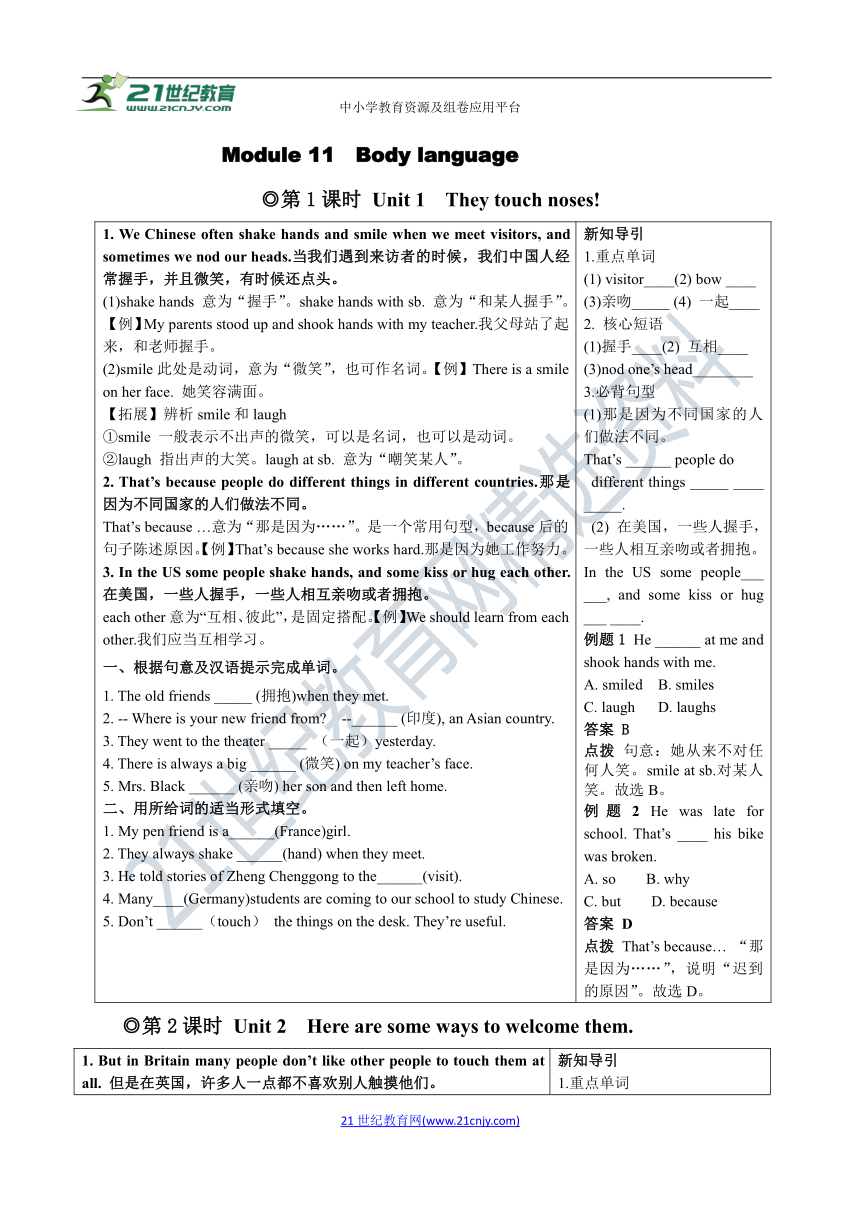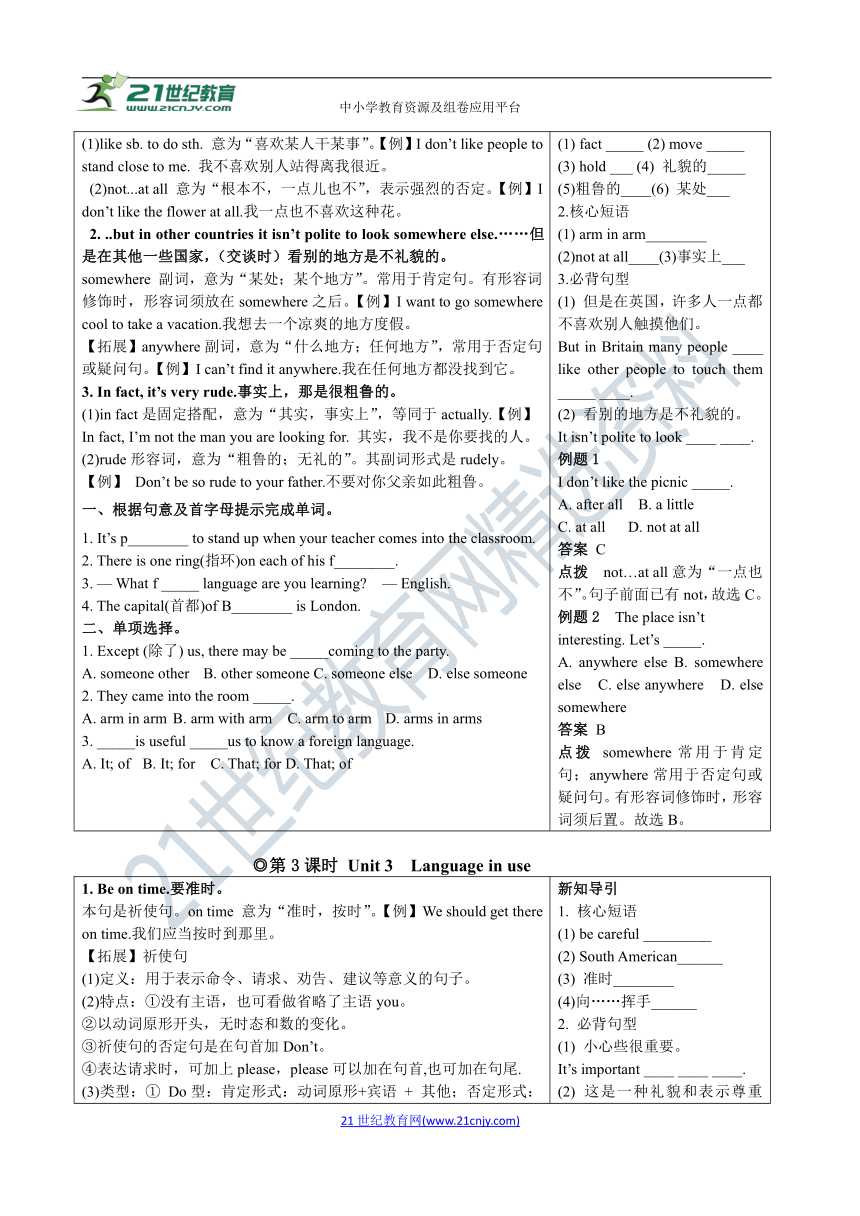Module 11 Body language 全模块同步学案(含答案)
文档属性
| 名称 | Module 11 Body language 全模块同步学案(含答案) |  | |
| 格式 | zip | ||
| 文件大小 | 1.2MB | ||
| 资源类型 | 试卷 | ||
| 版本资源 | 外研版 | ||
| 科目 | 英语 | ||
| 更新时间 | 2019-06-11 07:05:27 | ||
图片预览


文档简介
中小学教育资源及组卷应用平台
Module 11 Body language
◎第1课时 Unit 1 They touch noses!
1. We Chinese often shake hands and smile when we meet visitors, and sometimes we nod our heads.当我们遇到来访者的时候,我们中国人经常握手,并且微笑,有时候还点头。(1)shake hands 意为“握手”。shake hands with sb. 意为“和某人握手”。【例】My parents stood up and shook hands with my teacher.我父母站了起来,和老师握手。(2)smile此处是动词,意为“微笑”,也可作名词。【例】There is a smile on her face. 她笑容满面。 【拓展】辨析smile和laugh ①smile 一般表示不出声的微笑,可以是名词,也可以是动词。②laugh 指出声的大笑。laugh at sb. 意为“嘲笑某人”。2. That’s because people do different things in different countries.那是因为不同国家的人们做法不同。 That’s because …意为“那是因为……”。是一个常用句型,because后的句子陈述原因。【例】That’s because she works hard.那是因为她工作努力。3. In the US some people shake hands, and some kiss or hug each other. 在美国,一些人握手,一些人相互亲吻或者拥抱。each other意为“互相、彼此”,是固定搭配。【例】We should learn from each other.我们应当互相学习。一、根据句意及汉语提示完成单词。1. The old friends _____ (拥抱)when they met. 2. -- Where is your new friend from? --______ (印度), an Asian country.3. They went to the theater _____ (一起)yesterday. 4. There is always a big ______ (微笑) on my teacher’s face.5. Mrs. Black ______ (亲吻) her son and then left home.二、用所给词的适当形式填空。1. My pen friend is a______(France)girl. 2. They always shake ______(hand) when they meet.3. He told stories of Zheng Chenggong to the______(visit). 4. Many____(Germany)students are coming to our school to study Chinese. 5. Don’t ______(touch) the things on the desk. They’re useful. 新知导引1.重点单词 (1) visitor____(2) bow ____ (3)亲吻_____ (4) 一起____2. 核心短语(1)握手____(2) 互相____(3)nod one’s head________3.必背句型 (1)那是因为不同国家的人们做法不同。 That’s ______ people do different things _____ ____ _____. (2) 在美国,一些人握手,一些人相互亲吻或者拥抱。In the US some people___ ___, and some kiss or hug ___ ____. 例题1 He ______ at me and shook hands with me.A. smiled B. smiles C. laugh D. laughs答案 B 点拨 句意:她从来不对任何人笑。smile at sb.对某人笑。故选B。例题2 He was late for school. That’s ____ his bike was broken. A. so B. why C. but D. because答案 D点拨 That’s because… “那是因为……”,说明“迟到的原因”。故选D。
◎第2课时 Unit 2 Here are some ways to welcome them.
1. But in Britain many people don’t like other people to touch them at all. 但是在英国,许多人一点都不喜欢别人触摸他们。(1)like sb. to do sth. 意为“喜欢某人干某事”。【例】I don’t like people to stand close to me. 我不喜欢别人站得离我很近。 (2)not...at all 意为“根本不,一点儿也不”,表示强烈的否定。【例】I don’t like the flower at all.我一点也不喜欢这种花。 2. ..but in other countries it isn’t polite to look somewhere else.……但是在其他一些国家,(交谈时)看别的地方是不礼貌的。somewhere 副词,意为“某处;某个地方”。常用于肯定句。有形容词修饰时,形容词须放在somewhere之后。【例】I want to go somewhere cool to take a vacation.我想去一个凉爽的地方度假。 【拓展】anywhere副词,意为“什么地方;任何地方”,常用于否定句或疑问句。【例】I can’t find it anywhere.我在任何地方都没找到它。3. In fact, it’s very rude.事实上,那是很粗鲁的。(1)in fact是固定搭配,意为“其实,事实上”,等同于actually.【例】In fact, I’m not the man you are looking for. 其实,我不是你要找的人。 (2)rude形容词,意为“粗鲁的;无礼的”。其副词形式是rudely。 【例】 Don’t be so rude to your father.不要对你父亲如此粗鲁。一、根据句意及首字母提示完成单词。1. It’s p________ to stand up when your teacher comes into the classroom. 2. There is one ring(指环)on each of his f________. 3. — What f _____ language are you learning? — English. 4. The capital(首都)of B________ is London. 二、单项选择。1. Except (除了) us, there may be _____coming to the party. A. someone other B. other someone C. someone else D. else someone 2. They came into the room _____. A. arm in arm B. arm with arm C. arm to arm D. arms in arms 3. _____is useful _____us to know a foreign language. A. It; of B. It; for C. That; for D. That; of 新知导引1.重点单词(1) fact _____ (2) move _____ (3) hold ___ (4) 礼貌的_____ (5)粗鲁的____(6) 某处___2.核心短语 (1) arm in arm________ (2)not at all____(3)事实上___3.必背句型 (1) 但是在英国,许多人一点都不喜欢别人触摸他们。But in Britain many people ____ like other people to touch them _____ ____. (2) 看别的地方是不礼貌的。It isn’t polite to look ____ ____.例题1 I don’t like the picnic _____.A. after all B. a little C. at all D. not at all答案 C点拨 not…at all意为“一点也不”。句子前面已有not,故选C。例题2 The place isn’t interesting. Let’s _____.A. anywhere else B. somewhere else C. else anywhere D. else somewhere答案 B点拨 somewhere常用于肯定句;anywhere常用于否定句或疑问句。有形容词修饰时,形容词须后置。故选B。
◎第3课时 Unit 3 Language in use
1. Be on time.要准时。本句是祈使句。on time 意为“准时,按时”。【例】We should get there on time.我们应当按时到那里。 【拓展】祈使句 (1)定义:用于表示命令、请求、劝告、建议等意义的句子。(2)特点:①没有主语,也可看做省略了主语you。 ②以动词原形开头,无时态和数的变化。 ③祈使句的否定句是在句首加Don’t。 ④表达请求时,可加上please,please可以加在句首,也可加在句尾.(3)类型:① Do型:肯定形式:动词原形+宾语 + 其他;否定形式:Don’t+动词原形+宾语+其他。②Be型:肯定形式:Be+表语+其他;否定形式:Don’t+ be+表语+其他。③Let型:肯定形式:Let+宾语+动词原形+其他;否定形式:Don’t+ let+宾语+动词原形+其他/ Let+宾语+not+动词原形+其他。2. It’s important to be careful.小心些很重要。本句是It+ be +形容词+to do sth.句型,意为“做某事是……”。【例】It’s not polite to speak loudly in the library.在图书室大声说话是不礼貌的。 按要求转换句型,每空一词。1. Let him go swimming today. (改为否定祈使句). ______ ______ him go swimming today.2. Stand in line. (改为否定句) ______ ______ in line.3. You must be careful, Susan. (改为祈使句) ______ ______, Susan.4. Linda is often late for school. (改为否定祈使句) ______ _______ late for school, Linda.5. We go to school together. (改为祈使句) ______ ______ to school. 新知导引1. 核心短语 (1) be careful _________ (2) South American______(3) 准时________ (4)向……挥手______2. 必背句型 (1) 小心些很重要。 It’s important ____ ____ ____. (2) 这是一种礼貌和表示尊重的方式。 It’s ____ ____ ____being polite and showing respect.例题1 ____ wake up your sister.A. Don’t B. Doesn’t C. Aren’t D. Can’t答案 A点拨 祈使句的否定结构为:Don’t+动词原形+其他。故选A。 例题2 It’s important ____ careful when you are in the lab.A. be B. beingC. to be D. being to答案C点拨 本句是It+ be +形容词+to do sth.句型,意为“做某事是……”。故选C。
模块专题突破
专题讲座·聚焦写作
肢体语言
写作素材
1. a way to do sth.
2. shake hands 握手
3. each other 互相
4. nod one’s head 点头
5. say hello to sb. 向某人问好
典型例题
你班里要来五个国家的新生,他们分别来自英国、美国、印度、日本和俄罗斯,请你介绍与他们相处的方式。(60词)
________________________________________________________________________________________
____________________________________________________________________________________________________________________________________________________________________________________
范文 Hello! We have m (?http:?/??/?www.21cnjy.com?)any new foreign friends in our school now. Here are (1)some ways to welcome them. When we meet Americans, we can (2)shake hands, kiss or hug (3)each other. When we meet Indians, we should put our hands together and nod our heads. We can bow and say hello to Japanese when we meet them. If our friends are from Russia, we can kiss three times, left, right, left. 点评 (1) a way to do sth.意为“做某事的方式”。(2) shake hands 意为“握手”。 (3) each other意为“互相”。 (4) nod one’s head 意为“点头”。
Module 11
Unit 1
1.(1)游客;观光者(2)鞠躬;弯腰(3)kiss(4) together
2. (1)shake hands (2)each other (3)点头
3. (1)because; in different countries(2)shake hands each other
一、1. hugged 2. India 3. together 4. smile 5. kissed
二、1.kiss three 2. shake hands; smile; nod; heads 3. shake hands; kiss; hug 4. put; hands; no; heads 5. touch noses
Unit 2
1.(1)事实;细节(2)移动(3)握着;使不动(4) polite (5)rude (6)somewhere
2.(1)臂挽臂地(2)一点也不(3)in fact
3.(1)don’t; at all (2)somewhere else
一、1. polite 2. fingers 3. foreign 4. somewhere 5. rude
二、1. held 2. personal 3. feet 4.rudely 5.Britain
Unit 3
1.(1)小心,当心(2)南美人(3)on time (4)wave to
2. (1)to be careful (2)a way of
1. Don’t let 2. Don’t stand 3.Be careful 4. Don’t be
5. Let’s go
HYPERLINK "http://21世纪教育网(www.21cnjy.com)
" 21世纪教育网(www.21cnjy.com)
同课章节目录
- Module 1 Lost and found
- Unit 1 Whose bag is this?
- Unit 2 Are they yours?
- Unit 3 Language in use
- Module 2 What can you do ?
- Unit 1 I can play the piano
- Unit 2 I can run really fast
- Unit 3 Language in use
- Module 3 Making plans
- Unit 1 What are you going to do at the weekends?
- Unit 2 We're going to cheer the players.
- Unit 3 Language in use
- Module 4 Life in the future
- Unit 1 Everyone will study at home
- Unit 2 Every family will have a small plane.
- Unit 3 Language in use
- Module 5 Shopping
- Unit 1 What can I do for you?
- Unit 2 You can buy everything on the Internet
- Unit 3 Language in use
- Module 6 Around town
- Unit 1 Could you tell me how to get to the Nationa
- Unit 2 The London Eye is on your right.
- Unit 3 Language in use
- Revision module A
- Module 7 My past life
- Unit 1 I was born in a small village.
- Unit 2 I was born in Quincy.
- Unit 3 Language in use
- Module 8 Story time
- Unit 1 Once upon a time….
- Unit 2 Goldilocks hurried out of the house.
- Unit 3 Language in use
- Module 9 Life history
- Unit 1 He left school and began work at the age of
- Unit 2 He decided to be an actor.
- Unit 3 Language in use
- Module 10 A holiday journey
- Unit 1 What did you do?
- Unit 2 This morning we took a walk.
- Unit 3 Language in use
- Module 11 Body language
- Unit 1 They touch noses!
- Unit 2 Here are some ways to welcome them.
- Unit 3 Language in use
- Module 12 Western music
- Unit 1 It's so beautiful!
- Unit 2 Vienna is the centre of European classical
- Unit 3 Language in use
- Revision module B
